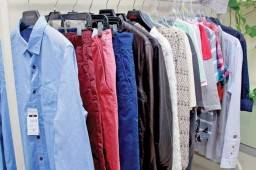
It has been a very defining year for India, with the new Prime Minister becoming the brand ambassador of the ‘upbeat India’. The positivity is reflected in almost every field with the image of stability being sent out to the buyers in Europe and the United States. This shall definitely benefit India, believe the country heads and buying office heads sitting in the country. While all buying and liaison offices confirmed that orders are definitely better than last year, but the windfall is still to happen…
Forecast for the holiday season is very optimistic, leading to the expectation of a buoyant spring/summer and buying offices in India too have noticed increased order placement from last year, which indicates a good season ahead for India. However, the orders are still coming in, so how ‘good’ the season will actually be is still anyone’s guess. “The orders are definitely coming in for us. We remain upbeat about India as a sourcing destination. There have been some stray cases where orders have flown in late but that is more due to the fact that we want to be as close to the season as possible to capture the latest trends,” informs Hitesh Mittal, DMM, Gap International Sourcing (India). Over the years orders have been moving nearer to the season, but that in no way reflects reduced orders, only a desire to delay order placements for commercial reasons.
The overall sourcing picture from India shows that buyers who are wholesale brands have already placed orders, as it is imminent for them to have goods in advance so that brand image and space at all point of sales is maintained; also most of the products are pre ordered merchandise. Similarly, the importers have also placed orders by now as the importers cater to a basic product category which has no fashion lifecycle and those have to be delivered as per a defined buying cycle. Both the wholesalers as well as the importers form the base of the selling and brand pyramid and are first to pick-up and stock goods, in a way setting the pace of the buying season.
For any brand to succeed and survive, the flow of orders has to continue to be regular. The retailer however is a separate question where with selling being lesser in the stores the demand for larger quantities is going down. “The retailers are slower and what I hear from most of them including the very big American and European stores, the trend seems to be to order closer to the season and smaller quantities but more bursts of fashion. This way they get a better sell through and overall it does send a signal to the market that quantities are going to be lesser, but this is not necessarily true,” says Vivek Bhatnagar, CEO, Fusion Consulting Service. Agreeing to the same, Alpana Razdan, GM, Falabella India shares her observations from her recent trip to the US, “Due to the slow economy and retail movement in USA, the customers are buying closer to the season to ensure better sell through. This has reduced the lead time but not necessarily the buying capacity.”

Besides the impact of overall improved market conditions, particularly in the US, S/S ’15 has many fashion elements that are India friendly which have spruced up the demand for Indian products. While Hitesh feels that India is an attractive destination for spring/summer mainly due to advantage of having a cotton base, Vivek highlights that S/S’15 in particular will be a more India-centric season as the base qualities are more viscose driven and viscose blends. In addition, there is a huge wave of silk that is going to be strong. Buying offices share that the hand feel and look that seems to be on trend is more casual with a softer and used look, the washes are very important be it the oil wash or the enzyme washed product. “These are the India-centric processes and this is definitely in the minds of European brands when they visualize India’s position in their minds,” adds Vivek.
The markets in EU have been very sluggish at sales point also due to the various brands looking similar during the autumn/winter months. Another aspect is that the brands also have poor sell through during A/W seasons as the cost per garment is higher and the disposable income sentiments are missing. However, with the S/S ’15 season being a more cotton and casual season, the unit value per article is also much lower therefore budgets are higher. In addition, summer months are more wide product based therefore India should gain. However, adding a note of caution Jayashree Rai of Triburg says, “Business is tough but I think India is doing better than many other destinations, but efforts to remain competitive have to continue with sincerity.”

Interestingly, the emerging markets in South America are also looking up, adding to the upsurge, more so as South American market works opposite cycles than the US/Europe. “South American retail is doing better than the traditional markets and hence sourcing has not been affected as such. For us the spring/summer buying will start around mid October and so far the trends indication received are not based on the Indian story, as detailed workmanship, handwork embellishments are not the key. However, what are driving the trends are fabric innovations; synthetics/rayon/metallic and prints along with semi structured garments,” shares Alpana.
There is a consensus on the fact that India is a land of diversity and that diversity is both India’s strength as well as its weakness. The diversity does not allow for centralizing the supply chain nor does it allow for processes to be brought under control and creation of a larger base for dyeing, printing and even fabric mills upgradation. This is therefore the weakest part of India as opposed to China and Bangladesh. Also the reality remains that despite all the noise on compliance issues, everyone needs Bangladesh due to the price and no duty advantage, at least until the consumer agrees to pay more.
In the meanwhile, China is losing business which it is immediately replacing by diving into partnerships and a marriage of convenience with Bangladeshi companies where fabrics are shipped in 16 days and production is done in Bangladesh and shipped back to China for selling to brands they have orders from. “China gets the advantage of better pricing and faster production and Bangladesh gets a larger turnover. This is killing India’s chances of getting the advantage of this China-Bangladesh situation,” avers Vivek.
However despite this developing nexus, many buying offices confirmed that orders are being shifted. “India is certainly benefiting due to the conditions in Bangladesh and China, and I see growth for the next year as well,” says Tanuja Sinha Roy, Country Manager, Sears Sourcing India, which is sourcing in India for Sears and K-mart. However, the advantage is on products that are India’s strength and many of the products that Bangladesh or China do are not even on the sourcing agenda of the buying offices. “Frankly, at Gap we have not seen any visible advantage of the situation in Bangladesh and orders are being placed based on competitiveness and capability,” says Hitesh.
In the South American market while China is losing ground, Bangladesh is emerging stronger and India is leading the fashion segment. “There has been a definite and strategic shift in buying strategy and buyers have already started to move or split the core business lines to Bangladesh to start building it as an alternate base to China. Currently, the situation in Bangladesh is considered stable and larger and compliant set-ups in Bangladesh are definitely benefiting the retailers. From India the next two seasons will be price and product driven, however buyers will go deep and narrow with their sourcing base. Design-led and full service vendors will benefit tremendously from this scenario,” reasons Alpana.
Many of the buying office heads felt that Indian exporters are falling short on grabbing opportunities even in the fashion segment as they are not building on their capabilities. Washing, product development, hand-feel and handwork are what have been India’s core strengths for a long time, but exporters are not able to offer faster productions across the board nor is there a large base of players who are able to offer a design driven collection that buyers can choose from and select and add into the collection, further very few are investing in fashion designers who actually design and work with same high street looks.
What comes out very clearly from discussion with numerous buying offices is that the biggest reasons why India should pick-up as the market conditions improve are still the same – stable political conditions, long term relationships that most times favour the buyer, classic products with a twist in fashion, flexibility, diversity in products and fabrics, better perception for its compliance and CSR sustaining fabrics and factories that are hot topics worldwide. “India is able to offer a nice destination for buyers to travel to which will ensure that business in India will continue to grow as travel advisory’s against Bangladesh and Pakistan benefit India, but China is so large a base that it shall always be a core production partner,” concludes Vivek.

Post a Comment